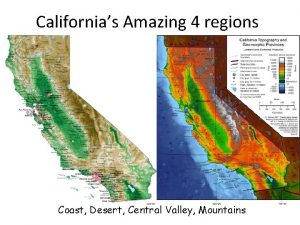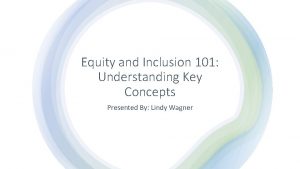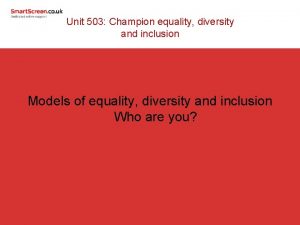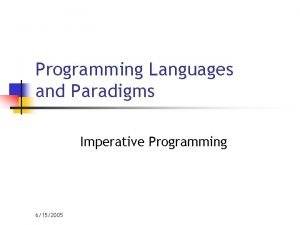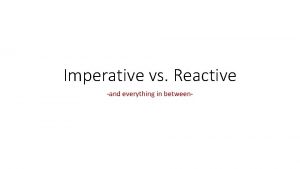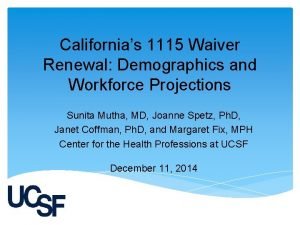The Economic Imperative Diversity Inclusion and Californias Demographics












- Slides: 12

The Economic Imperative: Diversity, Inclusion and California's Demographics Shifts Mayra Cruz, ASCCC Treasurer, CTELC Chair Dr. Olivia Herriford, Regional Director, Bay Area Community College Consortium Manuel Velez, ASCCC South Representative April 15, 2021 5: 15 5: 30 pm

Participants will… Explore these questions: ❑ How do we respond to these changes- demographic shift, climate change, structural racism and gender discrimination, and the shifts in economic power? ❑ How do we build on the social and cultural capital of students in the community college system to ensure that the opportunities for success and economic mobility are equitable? ❑ How do we reimagine our curriculum, practices, student supports, and services to address the economic disparities and to meet workforce needs? Generate concrete actions to take back to local academic senates and colleges. 2

Counterstory: A Personal Journey to a Better Future • Working class upbringing (In 2019 the poverty rate for Latinos in the U. S. was 17. 5 and for Blacks it was 18. 8 compared to the national average of 10. 5) • Child of Immigrants • Living in poverty • Struggles in secondary school (In 2018 the dropout rate for Black and Latino students exceeded the national average by as many as 6 percentage points) • Fitting in • Lower grades • A desire to continue my education (Between 1993 and 2018 Black and Latino enrollment in college increased by as much as 14 percentage points) • Financial Issues • Very few paths available • Finding myself in the community college (48% of Latino students and 36% of Black students attend public 2 -year colleges) • Support in applying for admissions • Financial Aid Support • A sense of community 3

Three Aspects of the Economic Imperative ❑ The Labor Shortage ❑ The Skills Gap ❑ The Education Gap/The Obligation Gap 4

Demographic Shifts ➢ People of color will become a majority of the American working class in 2032 ➢ An aging workforce ➢ California’s wealth gap continues to widen as the job market increasingly favors educated workers ➢ Black and Latino families are over-represented at the lower levels 5

Climate Change ➢ Impact the labor market and the nature of work ➢ Jobs will be eliminated and jobs will be created ➢ These shifts will require expanded (re)training programs 6

Structural Racism and Gender Discrimination ❖ Continue to be fundamental forces in our economy ❖ Structural racism shapes the status and power of people of color in the labor market ❖ Interventions must ensure access to jobs for people of color, gender -oppressed people and those historically marginalized from good jobs 7

Shifts in Economic Power ▪ Shifting power from people to firms ▪ While the economy booms, the majority of working people struggle with rising economic insecurity and declining standards of living ▪ What fuels an hourglass economy ▪ Rebuilding the middle class with collaborative workforce development 8

Impact of Covid-19: New Normal Recognize how work is changing and identify equitable interventions for change that benefit the most vulnerable students and skill-builders • The new world of work requires retooling and reskilling • Remote/hybrid education and jobs • Talent gaps in high-demand jobs continue to expand • More students need to work while they learn The integration of CTE and transfer pathways can provide those equitable interventions Example: Blue Collar AI 9

Demographic shifts While demographic shifts point towards a growing community of students of color, data shows that the majority of those students continue to begin their post-secondary journey at the community college: • Facilitate financial aid and increase scholarship opportunities • Build and strengthen relationships with community organizations • Embrace the student community’s diverse ethnic identities through public art/signage that reflects their cultural and linguistic traits • Work to re-imagine CTE through innovation and new programs • Advocate for the increase in baccalaureate degrees • Pursue state and federal grants that focus on students of color Share your ideas on how our individual colleges can address these shifts by posting them on our Padlet. Click on the following link to access it: https: //padlet. com/Manuel. JVelez/theeconomicimperative 10

Resources California Governor’s Council for Postsecondary Education. February 2021. Recovery with Equity: A Roadmap for Higher Education After the Pandemic. https: //www. capostsecondaryforall. org/initiatives/recovery-with-equity/ Re. Work the Bay, Working Partnerships USA & Jobs with Justice San Francisco. May 2020. Understanding & Responding to the Changing Nature of Work in the Bay Area. https: //www. wpusa. org/research/changing-nature-of-work-in-the-bay-area/ Public Policy Institute of California. (January 2020). Income Inequality in California. https: //www. ppic. org/publication/income-inequality-incalifornia/#: ~: text=A%20 large%20 wealth%20 gap%20 further%20 exacerbates%20 the%20 inc ome%20 gap. &text=However%2 C%20 wealth%20 is%20 more%20 unevenly, to%20 just%202% 25%20 of%20 Californians 11

For more information contact: info@asccc. org Mayra E. Cruz cruzmayra@deanza. edu Dr. Olivia Herriford olivia@baccc. net Manuel Velez mvelez@sdccd. edu 12
 Grade californias vaccine
Grade californias vaccine 4 regions of california
4 regions of california Diversity equity and inclusion 101
Diversity equity and inclusion 101 Diversity and inclusion scorecard
Diversity and inclusion scorecard Centre for gender diversity and inclusion statistics
Centre for gender diversity and inclusion statistics Diversity and inclusion consulting
Diversity and inclusion consulting Centre for gender diversity and inclusion statistics
Centre for gender diversity and inclusion statistics Korn ferry d&i maturity model
Korn ferry d&i maturity model Diversity training objectives
Diversity training objectives Dei pulse
Dei pulse Hse diversity equality and inclusion strategy
Hse diversity equality and inclusion strategy Mona talent priority
Mona talent priority Unit 503
Unit 503

